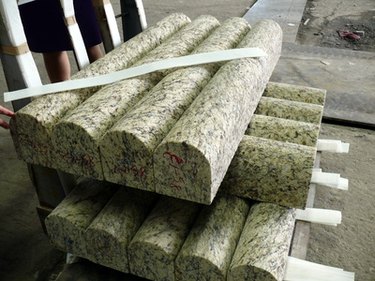Things You'll Need
Protective breathing mask
Double boiler *optional
Glass container *optional
For 1 gallon of Venetian Plaster:
Bucket
Wood stir stick
Lime putty - 64 ounces
Linseed oil - 12 ounces
Marble dust - 64 ounces
Lime-proof liquid pigment - 6 ounces
Olive oil soap - 2 tablespoons, melted

Venetian plaster first made an appearance in Ancient Rome. According to The Learning Channel, the plastering technique earned its name from its usage throughout Venice in the 1400s and is applied in up to ten layers. The plaster, a combination of lime, marble dust and natural oils, creates a finish similar to stucco when added in multiple layers. You can find the plaster ingredients at most paint and home improvement stores. You will need to make a lot of the Venetian plaster if you intend to finish your walls with this material.
Step 1
Put on a protective face mask to eliminate the inhalation of lime and marble dust. Put a bucket on an outside work surface. Add 64 ounces of lime putty to the bucket.
Video of the Day
Step 2
Stir in 64 ounces of marble dust with a wooden stir stick found at most paint stores. Continue mixing the putty and marble dust. Use a medium mixture of dust for a varied texture. Marble dust is sold in bags and commonly used by the kitchen, bathroom, fixture and pool construction industries.
Step 3
Melt olive oil soap in a double-boiler on a stove, or in a glass container in a microwave. Add 2 tablespoons of the melted soap to the mixture. Continue mixing with the stick.
Step 4
Pour in 12 ounces of Linseed oil and continue mixing. Once the mixture begins to form the consistency of plaster, add 6 ounces of liquid, lime-proof pigment. Traditionally, earth tones are used in the plaster pigment, but the Romans were also fond of reds. If the color does not mixing well, add water in small amounts to help the color spread smoothly, according to Online Tips. A teaspoon at a time is a good place to start. Stop adding water as soon as the plaster is tinted with the pigment shade. Be sure to use a lime-proof pigment or the lime will wash out the color.
Step 5
Use the Venetian plaster immediately according to your project needs.
Tip
Make a homemade putty of lime in a container with a lid by mixing lime powder with distilled water until the water will not absorb any more powder. Seal the container and allow it to settle for about 12 hours. Add more lime powder until the water will not absorb any more. Allow the water/powder to settle for 12 hours. Continue adding lime powder to the settled mixture and allowing it to settle for 12 hours until there is no separated water. Allow the mixture to remain sealed for about 2 weeks. Open the container, pour off the sediment and stir the putty. Putty can be stored.
Video of the Day